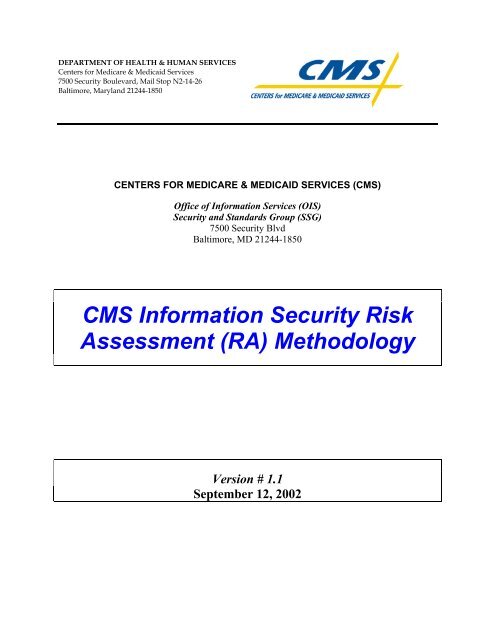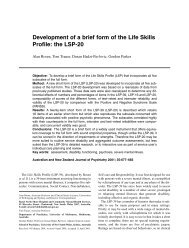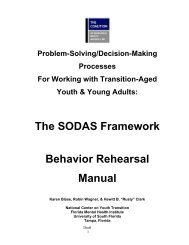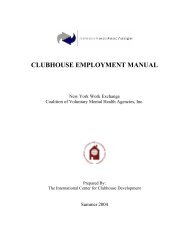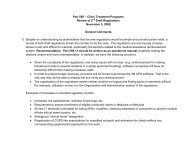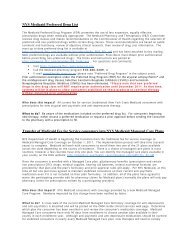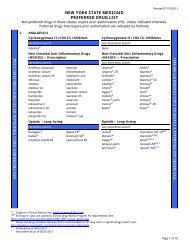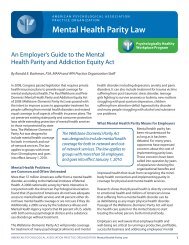CMS Information Security Risk Assessment (RA) Methodology
CMS Information Security Risk Assessment (RA) Methodology
CMS Information Security Risk Assessment (RA) Methodology
Create successful ePaper yourself
Turn your PDF publications into a flip-book with our unique Google optimized e-Paper software.
DEPARTMENT OF HEALTH & HUMAN SERVICES<br />
Centers for Medicare & Medicaid Services<br />
7500 <strong>Security</strong> Boulevard, Mail Stop N2-14-26<br />
Baltimore, Maryland 21244-1850<br />
CENTERS FOR MEDICARE & MEDICAID SERVICES (<strong>CMS</strong>)<br />
Office of <strong>Information</strong> Services (OIS)<br />
<strong>Security</strong> and Standards Group (SSG)<br />
7500 <strong>Security</strong> Blvd<br />
Baltimore, MD 21244-1850<br />
<strong>CMS</strong> <strong>Information</strong> <strong>Security</strong> <strong>Risk</strong><br />
<strong>Assessment</strong> (<strong>RA</strong>) <strong>Methodology</strong><br />
Version # 1.1<br />
September 12, 2002
<strong>CMS</strong> <strong>Information</strong> <strong>Security</strong> <strong>RA</strong> <strong>Methodology</strong><br />
Table of Contents<br />
Overview......................................................................................................................................... 1<br />
Purpose............................................................................................................................................ 2<br />
<strong>Risk</strong> <strong>Assessment</strong> Process ................................................................................................................ 2<br />
1 System Documentation Phase .................................................................................................. 2<br />
1.1 Document System Identification ....................................................................................... 3<br />
1.2 Document System Purpose and Description ..................................................................... 4<br />
1.3 Document System <strong>Security</strong> Level ..................................................................................... 4<br />
2 <strong>Risk</strong> Determination Phase ........................................................................................................ 5<br />
2.1 Identify System Environment Threats............................................................................... 5<br />
2.2 Identify System Vulnerabilities......................................................................................... 6<br />
2.3 Describe <strong>Risk</strong>..................................................................................................................... 6<br />
2.4 Identify Existing Controls ................................................................................................. 6<br />
2.5 Determine the Likelihood of Occurrence .......................................................................... 6<br />
2.6 Determine the Severity of Impact...................................................................................... 7<br />
2.7 Determine the <strong>Risk</strong> Level.................................................................................................. 8<br />
3 Safeguard Determination Phase ............................................................................................... 9<br />
3.1 Identify Safeguards.......................................................................................................... 10<br />
3.2 Determine Residual Likelihood of Occurrence............................................................... 11<br />
3.3 Determine Residual Severity of Impact........................................................................... 11<br />
3.4 Determine Residual <strong>Risk</strong> Level....................................................................................... 11<br />
Appendix A: <strong>Risk</strong> <strong>Assessment</strong> Process Flow ............................................................................... 12<br />
Appendix B: <strong>Security</strong> in the System Development Life Cycle .................................................... 13<br />
Appendix C: References ............................................................................................................... 15<br />
Appendix D: <strong>Information</strong> <strong>Security</strong> <strong>Risk</strong> <strong>Assessment</strong> Template................................................... 16<br />
September 12, 2002 / v 1.1<br />
Page i
<strong>CMS</strong> <strong>Information</strong> <strong>Security</strong> <strong>RA</strong> <strong>Methodology</strong><br />
Overview<br />
The Centers for Medicare & Medicaid Services (<strong>CMS</strong>) <strong>Information</strong> <strong>Security</strong> <strong>Risk</strong> <strong>Assessment</strong><br />
(<strong>RA</strong>) <strong>Methodology</strong> presents a systematic approach for the <strong>RA</strong> process of information computer<br />
systems within the <strong>CMS</strong> environment. This methodology describes the steps to produce an<br />
<strong>Information</strong> <strong>Security</strong> <strong>RA</strong> Report for systems that are part of a General Support System (GSS),<br />
Major Application (MA) or that are an “Other” System. The <strong>Information</strong> <strong>Security</strong> <strong>RA</strong> Report<br />
includes a system overview to provide a basic understanding of the system and its<br />
interconnections, and describe the overall system security level. Additionally, the <strong>RA</strong> Report<br />
contains a list of system threats and vulnerabilities; an evaluation of current security controls to<br />
safeguard against the identified threat/vulnerability pairs and the resulting risks levels; and the<br />
recommended safeguards to reduce the system’s risk exposure with a revised or residual risk<br />
level once the recommended safeguards are implemented.<br />
The <strong>RA</strong> process described in this methodology is an integral part of risk management. <strong>Risk</strong><br />
Management also includes prioritization of risks, categorization of recommended safeguards,<br />
their feasibility of implementation, and other risk mitigation processes and solutions within the<br />
management, operational and technical environment. These risk management activities are<br />
beyond the scope of this methodology and are performed as part of the system’s certification and<br />
accreditation process as it affects the organization’s security posture and management assesses<br />
an acceptable level of risk for continuation of operations.<br />
The <strong>RA</strong> process is presented as the following three phases:<br />
• System Documentation Phase<br />
• <strong>Risk</strong> Determination Phase<br />
• Safeguard Determination Phase<br />
The following appendices are included in the methodology to assist the system owner or <strong>RA</strong><br />
author in the risk assessment analysis and provide further clarification and references to<br />
complete the <strong>Information</strong> <strong>Security</strong> <strong>RA</strong> Report:<br />
Appendix A, <strong>Risk</strong> <strong>Assessment</strong> Process Flow – Depicts the <strong>RA</strong> process flow detailed in this<br />
methodology for ease of reference.<br />
Appendix B, <strong>Security</strong> in the System Development Life Cycle – Describes system security<br />
deliverables and resources as they relate to the System Development Life Cycle and the <strong>CMS</strong><br />
Roadmap.<br />
Appendix C, References – Provides links to web sites for documents referred to or used as<br />
background in this <strong>Information</strong> <strong>Security</strong> <strong>RA</strong> <strong>Methodology</strong>.<br />
Appendix D, <strong>CMS</strong> <strong>Information</strong> <strong>Security</strong> <strong>RA</strong> Template – Facilitates the <strong>RA</strong> report<br />
documentation, and provides a common and consistent format for the <strong>Information</strong> <strong>Security</strong> <strong>RA</strong><br />
report.<br />
Refer to the <strong>CMS</strong> <strong>Information</strong> <strong>Security</strong> Terms and Definitions document for information security<br />
terms used throughout this methodology.<br />
September 12, 2002 / v 1.1 page 1
<strong>CMS</strong> <strong>Information</strong> <strong>Security</strong> <strong>RA</strong> <strong>Methodology</strong><br />
Purpose<br />
The <strong>CMS</strong> <strong>Information</strong> <strong>Security</strong> <strong>RA</strong> <strong>Methodology</strong> has been developed as a tool to guide system<br />
owners and <strong>RA</strong> authors in evaluating and documenting the system’s management, operational<br />
and technical security environment. This tool describes the steps to produce the <strong>CMS</strong><br />
<strong>Information</strong> <strong>Security</strong> <strong>Risk</strong> <strong>Assessment</strong> Report, which is incorporated into the System <strong>Security</strong><br />
Plan (SSP) and is reviewed during the <strong>CMS</strong> <strong>Information</strong> <strong>Security</strong> Certification and Accreditation<br />
process. The system <strong>RA</strong> process supports risk management in the evaluation of the system(s)<br />
risk impact upon <strong>CMS</strong>’ enterprise security model.<br />
<strong>CMS</strong> requires each system to have an <strong>Information</strong> <strong>Security</strong> <strong>RA</strong> in each of the following<br />
instances: new system, operational legacy system, major system modification(s), increase<br />
security risks/exposure, increase of overall system security level, serious security violation(s) as<br />
described the <strong>CMS</strong> Computer <strong>Security</strong> Incident Handling Procedures document, and security<br />
evaluations and/or audits. For a new system or a system undergoing a major modification, an<br />
<strong>RA</strong> will be developed as part of the System Development Life Cycle (SDLC) phases. The <strong>RA</strong><br />
steps are illustrated in Appendix B of this methodology and the <strong>RA</strong> Template is provided in<br />
Appendix D.<br />
<strong>Risk</strong> <strong>Assessment</strong> Process<br />
To perform the information security risk assessment, the system owner must identify the<br />
system’s threats and associated vulnerabilities. For each threat/vulnerability pair, the system<br />
owner determines the severity of impact upon the system’s confidentiality, integrity and<br />
availability, and determines the likelihood of the vulnerability exploit occurring given existing<br />
security controls. The product of the likelihood of occurrence and the impact severity results in<br />
the risk level for the system based on the exposure to the threat/vulnerability pair.<br />
Once the risk level is determined for each threat/vulnerability pair, safeguards are identified for<br />
pairs with moderate or high risk levels. The risk is re-evaluated to determine the remaining risk,<br />
or residual risk level, after the recommended safeguard is implemented.<br />
1 System Documentation Phase<br />
The System Documentation Phase provides background information to describe the system and<br />
the data it handles, as <strong>CMS</strong> assets in support of or in fulfillment of the organization’s business<br />
mission. This phase establishes a framework for subsequent <strong>RA</strong> phases.<br />
The system owner must provide system identification to include system description, business<br />
function and assets, and system security level determination. For new systems, these are defined<br />
when the system is first conceived and developed during the SDLC’s design and implementation<br />
phases of the system. These steps are illustrated in the top section in Appendix A: <strong>Risk</strong><br />
<strong>Assessment</strong> Process Flow, Figure A-1.<br />
September 12, 2002 / v 1.1 page 2
<strong>CMS</strong> <strong>Information</strong> <strong>Security</strong> <strong>RA</strong> <strong>Methodology</strong><br />
1.1 Document System Identification<br />
Document the system name, other related information, and the responsible organization. The<br />
system must be categorized as part of a General Support System (GSS), Major Application (MA)<br />
or be an “Other” Systems, according to the <strong>CMS</strong> SSP <strong>Methodology</strong>.<br />
Official System Name<br />
System Acronym<br />
System of Records (SOR)<br />
Financial Management Investment<br />
Board (FMIB) Number<br />
Web Support Team (WST) Number<br />
System Type (select one)<br />
GSS, MA or “Other” System<br />
Name of Organization<br />
Address<br />
City, State, Zip<br />
Contract Number, Contractor<br />
contact information (if applicable)<br />
Identify system contacts information for system owner/manager name, business owner/manager,<br />
system maintainer manager and <strong>RA</strong> author. If applicable, provide contractor information, (i.e.,<br />
contractor name, contract number, contact, e-mail address and phone number, project<br />
officer/GTL name, e-mail address and phone number.)<br />
Name of Individual<br />
Title<br />
Name of Organization<br />
Address<br />
Mailstop<br />
City, State, Zip<br />
Email Address<br />
Phone number<br />
Contractor contact information (if<br />
applicable)<br />
September 12, 2002 / v 1.1 page 3
<strong>CMS</strong> <strong>Information</strong> <strong>Security</strong> <strong>RA</strong> <strong>Methodology</strong><br />
Identify the individual(s) responsible for security and the component’s <strong>Information</strong> System<br />
<strong>Security</strong> Officer.<br />
Name (Component ISSO)<br />
Title<br />
Name of Organization<br />
Address<br />
Mailstop<br />
City, State, Zip<br />
Email Address<br />
Phone number<br />
Emergency Contact <strong>Information</strong><br />
(name, phone and e-mail only)<br />
1.2 Document System Purpose and Description<br />
(Asset Identification)<br />
To identify the assets covered by the <strong>RA</strong>, provide a brief description of the function and purpose<br />
of the system and the organizational business processes supported, including functions and<br />
processing of data. If it is part of a GSS, include all supported applications, as well as functions<br />
and information processed.<br />
1.2.1 Document System Environment and Special Considerations<br />
Provide a brief general technical description of the system. Discuss any environmental factors<br />
that raise special security concerns and document the physical location of the system. Provide a<br />
network diagram or schematic to help identify, define, and clarify the system boundaries for the<br />
system, and a general description of the system.<br />
1.2.2 Document System Interconnection/<strong>Information</strong> Sharing<br />
For GSSs, show how the various components and sub-networks are connected and/or<br />
interconnected to any other Local Area Network (LAN) or Wide Area Network (WAN). For<br />
MAs and “Other” Systems provide a description of the system and sub-applications or other<br />
software interdependencies.<br />
1.3 Document System <strong>Security</strong> Level<br />
Describe and document the information handled by the system and identify the overall system<br />
security level as LOW, MODE<strong>RA</strong>TE, or HIGH. This element includes a general description of<br />
the information, the information sensitivity, and system criticality; which includes requirements<br />
for confidentiality, integrity and availability, auditability and accountability as dictated by <strong>CMS</strong><br />
information security policy. Refer to the <strong>CMS</strong> <strong>Information</strong> <strong>Security</strong> Levels document on<br />
<strong>CMS</strong>net.cms.hhs.gov/CyberTyger.<br />
September 12, 2002 / v 1.1 page 4
<strong>CMS</strong> <strong>Information</strong> <strong>Security</strong> <strong>RA</strong> <strong>Methodology</strong><br />
2 <strong>Risk</strong> Determination Phase<br />
The goal of the <strong>Risk</strong> Determination Phase is to calculate the level of risk for each<br />
threat/vulnerability pair based on: (1) the likelihood of a threat exploiting a vulnerability; and (2)<br />
the severity of impact that the exploited vulnerability would have on the system, its data and its<br />
business function in terms of loss of confidentiality, loss of integrity and loss of availability.<br />
The <strong>Risk</strong> Determination Phase is comprised of six steps:<br />
1. Identify potential dangers to information and system (threats).<br />
2. Identify the system weakness that could be exploited (vulnerabilities) associated to<br />
generate the threat/vulnerability pair.<br />
3. Identify existing controls to reduce the risk of the threat to exploit the vulnerability.<br />
4. Determine the likelihood of occurrence for a threat exploiting a related vulnerability<br />
given the existing controls.<br />
5. Determine the severity of impact on the system by an exploited vulnerability.<br />
6. Determine the risk level for a threat/vulnerability pair given the existing controls.<br />
This six-step process for <strong>Risk</strong> Determination is conducted for each identified threat/vulnerability<br />
pair. These steps are illustrated in the center section of Appendix A: <strong>Risk</strong> <strong>Assessment</strong> Process<br />
Flow, Figure A-1. Use the following table, Table 1, to document the analysis performed in this<br />
phase.<br />
Table 1. <strong>Risk</strong> Determination Phase Table<br />
Item<br />
No.<br />
Threat<br />
Name<br />
Vulnerability<br />
Name<br />
<strong>Risk</strong> Description<br />
Existing<br />
Controls<br />
Likelihood<br />
of<br />
Occurrence<br />
Impact<br />
Severity<br />
<strong>Risk</strong><br />
Level<br />
The Item Number designated in the left-most column is for reference purposes only. It is<br />
assigned in numerical order as rows are added to the table for different threat/vulnerability pairs.<br />
The Item No. is also used in Table 5 in the Safeguard Determination Phase, to correlate the<br />
analysis done in both tables.<br />
2.1 Identify System Environment Threats<br />
Identify threats that could have the ability to exploit system vulnerabilities. Refer to the <strong>CMS</strong><br />
Threat Identification Resource for environmental/physical, human, natural, and technical threats<br />
that may affect General Support Systems, Major Applications, and Other Systems, when<br />
applicable. The system owner must consider interconnection and interdependencies with other<br />
systems that may introduce new threats to the system under review. Therefore, an understanding<br />
of the system’s interconnections and subordinate processes, if any, will provide significant<br />
September 12, 2002 / v 1.1 page 5
<strong>CMS</strong> <strong>Information</strong> <strong>Security</strong> <strong>RA</strong> <strong>Methodology</strong><br />
information regarding inherited and new risks and controls that may affect the system and they<br />
must be identified in this section.<br />
Complete columns labeled “Item No.” and “Threat Name” in Table 1 with the result of this step.<br />
2.2 Identify System Vulnerabilities<br />
Identify vulnerabilities associated with each threat to produce a threat/vulnerability pair.<br />
Vulnerabilities may be associated with either a single or multiple threats.<br />
Previous risk assessment documentation, audit and system deficiencies reports, security<br />
advisories and bulletins, automated tools and technical security evaluations may be used to<br />
identify threats and vulnerabilities. Testing results during and after system development as part<br />
of the system’s SDLC may be used to identify vulnerabilities for new systems or systems<br />
undergoing major modifications.<br />
Complete the column labeled “Vulnerability Name” in Table 1 with the result of this step.<br />
2.3 Describe <strong>Risk</strong><br />
Describe how the vulnerability creates a risk in the system in terms of confidentiality, integrity<br />
and/or availability elements that may result in a compromise of the system and the data it<br />
handles.<br />
Complete the column labeled “<strong>Risk</strong> Description” in Table 1 with the result of this step.<br />
2.4 Identify Existing Controls<br />
Identify existing controls that reduce: (1) the likelihood or probability of a threat exploiting an<br />
identified system vulnerability, and/or (2) the magnitude of impact of the exploited vulnerability<br />
on the system. Existing controls may be management, operational and/or technical controls<br />
depending on the identified threat/vulnerability pair and the risk to the system.<br />
Complete the column labeled “Existing Controls” in Table 1 with the result of this step.<br />
2.5 Determine the Likelihood of Occurrence<br />
Determine the likelihood that a threat will exploit a vulnerability. The likelihood is an estimate<br />
of the frequency or the probability of such an event. Likelihood of occurrence is based on a<br />
number of factors that include system architecture, system environment, information system<br />
access and existing controls; the presence, motivation, tenacity, strength and nature of the threat;<br />
and the presence of vulnerabilities; and the effectiveness of existing controls.<br />
Refer to the information provided in Table 2 for guidelines to determine the likelihood of<br />
occurrence that the threat is realized and exploits the system’s vulnerability.<br />
September 12, 2002 / v 1.1 page 6
<strong>CMS</strong> <strong>Information</strong> <strong>Security</strong> <strong>RA</strong> <strong>Methodology</strong><br />
Complete the column labeled “Likelihood of Occurrence” in Table 1 with the result of this step.<br />
Table 2. Likelihood of Occurrence Levels<br />
Likelihood<br />
Negligible<br />
Very Low<br />
Low<br />
Medium<br />
High<br />
Very High<br />
Extreme<br />
Description<br />
Unlikely to occur.<br />
Likely to occur two/three times every five years.<br />
Likely to occur one every year or less.<br />
Likely to occur once every six months or less.<br />
Likely to occur once per month or less.<br />
Likely to occur multiple times per month<br />
Likely to occur multiple times per day<br />
2.6 Determine the Severity of Impact<br />
Determine the magnitude or severity of impact on the system’s operational capabilities and data<br />
if the threat is realized and exploits the associated vulnerability. Determine the severity of<br />
impact for each threat/vulnerability pair by evaluating the potential loss in each security category<br />
(confidentiality, integrity and availability) based on the system’s information security level as<br />
explained in the <strong>CMS</strong> <strong>Information</strong> <strong>Security</strong> Levels document and described in the System<br />
Documentation Phase of this methodology. The impact can be measured by loss of system<br />
functionality, degradation of system response time or inability to meet a <strong>CMS</strong> business mission,<br />
dollar losses, loss of public confidence, or unauthorized disclosure of data.<br />
Refer to Table 3 for guidelines on impact severity levels.<br />
September 12, 2002 / v 1.1 page 7
<strong>CMS</strong> <strong>Information</strong> <strong>Security</strong> <strong>RA</strong> <strong>Methodology</strong><br />
Impact Severity<br />
Insignificant<br />
Minor<br />
Significant<br />
Damaging<br />
Serious<br />
Critical<br />
Table 3. Impact Severity Levels<br />
Description<br />
Will have almost no impact if threat is realized and exploits<br />
vulnerability.<br />
Will have some minor effect on the system. It will require<br />
minimal effort to repair or reconfigure the system.<br />
Will result in some tangible harm, albeit negligible and perhaps<br />
only noted by a few individuals or agencies. May cause<br />
political embarrassment. Will require some expenditure of<br />
resources to repair.<br />
May cause damage to the reputation of system management,<br />
and/or notable loss of confidence in the system’s resources or<br />
services. It will require expenditure of significant resources to<br />
repair.<br />
May cause considerable system outage, and/or loss of<br />
connected customers or business confidence. May result in<br />
compromise or large amount of Government information or<br />
services.<br />
May cause system extended outage or to be permanently closed,<br />
causing operations to resume in a Hot Site environment. May<br />
result in complete compromise of Government agencies’<br />
information or services.<br />
Complete the column labeled “Impact Severity” in Table 1 with the result of this step.<br />
2.7 Determine the <strong>Risk</strong> Level<br />
The risk can be expressed in terms of the likelihood of the threat exploiting the vulnerability and<br />
the impact severity of that exploitation on the confidentiality, integrity and availability of the<br />
system. Mathematically, the <strong>Risk</strong> Level is equal to the Likelihood of Occurrence multiplied by<br />
the Severity of Impact in the system’s confidentiality, integrity and availability. Table 4 shows<br />
risk levels resulting from the affect of both parameters on the risk level. The system owner may<br />
increase the risk to a higher level depending on the system’s information security level and the<br />
level of compromise if a threat is realized.<br />
September 12, 2002 / v 1.1 page 8
<strong>CMS</strong> <strong>Information</strong> <strong>Security</strong> <strong>RA</strong> <strong>Methodology</strong><br />
Table 4. <strong>Risk</strong> Levels<br />
Likelihood<br />
of<br />
Occurrence<br />
Impact Severity<br />
Insignificant Minor Significant Damaging Serious Critical<br />
Negligible Low Low Low Low Low Low<br />
Very Low Low Low Low Low Moderate Moderate<br />
Low Low Low Moderate Moderate High High<br />
Medium Low Low Moderate High High High<br />
High Low Moderate High High High High<br />
Very High Low Moderate High High High High<br />
Extreme Low Moderate High High High High<br />
Complete the column labeled “<strong>Risk</strong> Level” in Table 1 with the result of this step.<br />
3 Safeguard Determination Phase<br />
The Safeguard Determination Phase involves identification of additional controls, safeguards or<br />
corrective actions to minimize the threat exposure and vulnerability exploitation for each<br />
threat/vulnerability pairs identified in the <strong>Risk</strong> Determination Phase and resulting in moderate or<br />
high risk levels. Identification of new security measures should address the level of risk already<br />
assessed for the threat/vulnerability pair and should reduce the risk level. The residual risk level<br />
is determined assuming full implementation of the recommended controls/safeguards.<br />
The Safeguard Determination Phase is comprised of four steps:<br />
1. Identify the controls/safeguards to reduce the risk level of an identified<br />
threat/vulnerability pair, if the risk level is moderate or high.<br />
2. Determine the residual likelihood of occurrence of the threat if the recommended<br />
safeguard is implemented.<br />
3. Determine the residual impact severity of the exploited vulnerability once the<br />
recommended safeguard is implemented.<br />
4. Determine the residual risk level for the system.<br />
These steps are illustrated in the bottom section of Appendix A: <strong>Risk</strong> <strong>Assessment</strong> Process Flow,<br />
Figure A-1.<br />
Table 5 can be used to summarize the analysis performed during the Safeguard Determination<br />
Phase.<br />
September 12, 2002 / v 1.1 page 9
<strong>CMS</strong> <strong>Information</strong> <strong>Security</strong> <strong>RA</strong> <strong>Methodology</strong><br />
Table 5. Safeguard Determination Phase Table<br />
Item<br />
No.<br />
Recommended<br />
Safeguard Description<br />
Residual<br />
Likelihood of<br />
Occurrence<br />
Residual<br />
Impact<br />
Severity<br />
Residual <strong>Risk</strong><br />
Level<br />
Use the Item Numbers created for Table 1 as reference in Table 5 to correlate the analysis<br />
summarized in both tables to the same threat/vulnerability pair and associated risk level. The<br />
Items Numbers here are used to maintain consistency, and ease of reference, and match a<br />
recommended safeguard to a threat/vulnerability pair. They refer back to the same item numbers<br />
used in the <strong>Risk</strong> Determination Phase for the threat/vulnerability pairs that resulted in moderate<br />
or high risk levels.<br />
3.1 Identify Safeguards<br />
Identify controls/safeguards for each threat/vulnerability pair with a moderate or high risk level<br />
as identified in the <strong>Risk</strong> Determination Phase. The purpose of the recommended safeguard is to<br />
reduce or minimize the level of risk. When identifying a safeguard, consider the:<br />
(1) <strong>Security</strong> area where the control/safeguard belongs, such as management, operational,<br />
technical;<br />
(2) Method the control/safeguard employs to reduce the opportunity for the threat to exploit<br />
the vulnerability;<br />
(3) Effectiveness of the proposed control/safeguard to mitigate the risk level; and<br />
(4) Policy and architectural parameters required for implementation in the <strong>CMS</strong><br />
environment.<br />
Recommended safeguards will address the security category identified during the risk analysis<br />
process (confidentiality, integrity and availability) that may be compromised by the exploited<br />
vulnerability.<br />
Complete the column labeled “Recommended Safeguard” in Table 5 with the result of this step.<br />
If more than one safeguard is identified for the same threat/vulnerability pair, list them in this<br />
column in separate rows and continue with the analysis steps: the residual risk level must be<br />
evaluated during this phase of the assessment and may be further evaluated in risk management<br />
activities outside of the scope of this methodology.<br />
If a complete implementation of the recommended safeguard cannot be achieved in the <strong>CMS</strong><br />
environment due to management, operational or technical constraints, annotate the circumstances<br />
in this space and continue with the analysis.<br />
September 12, 2002 / v 1.1 page 10
<strong>CMS</strong> <strong>Information</strong> <strong>Security</strong> <strong>RA</strong> <strong>Methodology</strong><br />
3.2 Determine Residual Likelihood of Occurrence<br />
Follow the directions described in Section 2.4 of the <strong>Risk</strong> Determination Phase while assuming<br />
full implementation of the recommended safeguard.<br />
Complete the column labeled “Residual Likelihood of Occurrence” in Table 5 with the result of<br />
this step.<br />
3.3 Determine Residual Severity of Impact<br />
Follow the directions described in Section 2.5 of the <strong>Risk</strong> Determination Phase while assuming<br />
full implementation of the recommended safeguard.<br />
Complete the column labeled “Residual Impact Severity” in Table 5 with the result of this step.<br />
3.4 Determine Residual <strong>Risk</strong> Level<br />
Determine the residual risk level for the threat/vulnerability pair and its associated risk once the<br />
recommended safeguard is implemented. The residual risk level is determined by examining the<br />
likelihood of occurrence of the threat exploiting the vulnerability and the impact severity factors<br />
in categories of Confidentiality, Integrity and Availability.<br />
Follow the directions described in Section 2.6 of the <strong>Risk</strong> Determination Phase to determine the<br />
residual risk level once the recommended safeguard is fully implemented.<br />
Depending on the nature and circumstances of threats and vulnerabilities, a recommended<br />
safeguard may reduce the risk level to Low. Annotate with a narrative below the table, if<br />
needed, if such special conditions exist.<br />
Complete the column labeled “Residual <strong>Risk</strong> Level” in Table 5 with the result of this step.<br />
September 12, 2002 / v 1.1 page 11
<strong>CMS</strong> <strong>Information</strong> <strong>Security</strong> <strong>RA</strong> <strong>Methodology</strong><br />
Appendix A: <strong>Risk</strong> <strong>Assessment</strong> Process Flow<br />
Figure A-1: <strong>Risk</strong> <strong>Assessment</strong> Process Flow<br />
System<br />
Documentation Phase<br />
1.1 Document System Identification<br />
Figure 3-1. <strong>Risk</strong> <strong>Assessment</strong> Process Flow<br />
1.2 Document System Purpose and Description<br />
1.3 Document the System <strong>Security</strong> Level<br />
2.1 Identify Threats<br />
2.2 Identify Vulnerabilities<br />
<strong>Risk</strong> Determination Phase<br />
2.5 Determine Likelihood of<br />
Occurrence<br />
2.3 <strong>Risk</strong> Description<br />
2.4 Identify Existing Controls<br />
2.6 Determine Severity of<br />
Impact<br />
2.7 Determine <strong>Risk</strong> Level<br />
Safeguard Determination<br />
Phase<br />
3.1 Recommend Control/Safeguard<br />
3.2 Determine Residual<br />
Likelihood of Occurrence<br />
3.4 Determine Residual <strong>Risk</strong> Level<br />
3.3 Determine Residual<br />
Severity of Impact<br />
September 12, 2002 / v 1.1 page 12
<strong>CMS</strong> <strong>Information</strong> <strong>Security</strong> <strong>RA</strong> <strong>Methodology</strong><br />
Appendix B: <strong>Security</strong> in the System Development Life Cycle<br />
Although information security must be considered in all phases of the life of a system, the<br />
System Development Life Cycle identifies four specific steps that are needed to ensure that<br />
information at <strong>CMS</strong> is properly protected. These include the <strong>Information</strong> Sensitivity <strong>Assessment</strong><br />
(Section 10.5 of the Business Case Analysis), System Requirements Document, the <strong>RA</strong> Report<br />
and the System <strong>Security</strong> Plan.<br />
Step 1 - The <strong>Information</strong> Sensitivity <strong>Assessment</strong> (ISA)<br />
Prior to project initiation, the system owner prepares a Business Case Analysis (BCA),<br />
which includes the ISA (section 10.5 of the BCA). In this step, the system owner<br />
categorizes the data according to sensitivity and identifies high-level security<br />
requirements that apply to the system under consideration for development. <strong>Information</strong><br />
from the ISA is one of the factors considered in determining if the system will go forward<br />
into development and what level of information security will be needed. Elements from<br />
the ISA provide the initial input to the <strong>RA</strong>.<br />
Step 2 –System Requirements Document (specifically <strong>Security</strong> Requirements)<br />
As an initial step of the development process, system requirements are documented for<br />
every system. The security requirements serve as a baseline for security within the<br />
system. The <strong>CMS</strong> Minimum <strong>Information</strong> <strong>Security</strong> Standards is a tool to assist in defining<br />
security requirements. Other requirements may be determined by business or functional<br />
requirements.<br />
Step 3 – <strong>Risk</strong> <strong>Assessment</strong> Report<br />
During the development process, a risk assessment is conducted and the result <strong>RA</strong> Report<br />
documents the vulnerabilities that have been identified in the system, the risks to the<br />
system resulting from the vulnerabilities and the efforts designed to reduce those risks,<br />
through the use of safeguards. The <strong>RA</strong> Report provides input to the System <strong>Security</strong> Plan<br />
and other risk management activities.<br />
Step 4 – System <strong>Security</strong> Plan<br />
The System <strong>Security</strong> Plan incorporates all of the elements required for the system owner<br />
to determine if the system should be certified as meeting both <strong>CMS</strong> policy and business<br />
requirements. <strong>Information</strong> from the <strong>RA</strong> Report is incorporated into the System <strong>Security</strong><br />
Plan in Section 2 – Management Controls.<br />
<strong>Security</strong> steps also correspond to phases in the Integrated IT Investment Management Road Map<br />
(ROADMAP) for system development. The ROADMAP is <strong>CMS</strong>’ implementation standard for<br />
SDLC and Investment Management and can be found on<br />
HCFAnet.HCFA.gov/roadmap/intro/roadmap.htm. In Figure B-1, the system development life<br />
cycle and ROADMAP are shown on the right and left sides with the information security<br />
deliverables and tools entered in the center section between them. This format illustrates the<br />
relationship of the information security tasks to both processes.<br />
September 12, 2002 / v 1.1 page 13
<strong>CMS</strong> <strong>Information</strong> <strong>Security</strong> <strong>RA</strong> <strong>Methodology</strong><br />
Figure B-1. <strong>Security</strong> in the System Development Life Cycle and <strong>CMS</strong>’ Roadmap<br />
System <strong>Security</strong> in the SDLC<br />
Pre-Development<br />
1. Express need for system<br />
2. Assess/determine data sensitivity<br />
3. Define initial security requirements<br />
<strong>Security</strong><br />
Deliverables<br />
(rectangle) &<br />
Resources (oval)<br />
IT Investment<br />
Management<br />
Road Map<br />
Development<br />
1. Identify detailed system security requirements<br />
during system design.<br />
2. Develop appropriate security controls with<br />
evaluation & test procedures prior procurement<br />
actions<br />
3. Develop solicitation documents to include security<br />
requirements & evaluation/test procedures<br />
4. Update security requirements as technologies are<br />
implemented<br />
5. Identify security requirements for procurement of COTS<br />
applications components<br />
6. Perform design review to ensure security controls are<br />
considered prior to production<br />
7. Ensure security features are configured, enables,<br />
tested, and documented during development<br />
8. Update, design, perform and document newly<br />
developed security controls<br />
9. Document system security tests and risk<br />
assessment<br />
10. Ensure compliance with Federal laws, regulations,<br />
policies and standards<br />
11. Certify system and obtain system accreditation<br />
12. Provide security training<br />
Post-Development<br />
1. Document all security activities<br />
2. Perform security operations and administration<br />
a. Perform backups<br />
b. Provide security training<br />
c. Maintain & review user admin & access<br />
privileges<br />
d. Update security software as required<br />
e. Update security procedures as required<br />
3. Perform operational assurance<br />
a. Perform & document periodic security audits<br />
b. Perform & document monitoring of system<br />
security<br />
c. Evaluate & document results of security<br />
monitoring<br />
d. Perform & document corrective actions<br />
e. Test contingency plans on a regular basis<br />
f. Perform <strong>Risk</strong> <strong>Assessment</strong> and update<br />
<strong>Security</strong> Plan, as needed, with each<br />
configuration change or every year<br />
4. Document disposal of information<br />
5. Use controls to ensure confidentiality of information<br />
Business Case Analysis<br />
10.5 - <strong>Information</strong><br />
Sensitivity<br />
Minimum<br />
<strong>Security</strong><br />
Standards<br />
System<br />
Requirements<br />
Document (includes<br />
security)<br />
Threat<br />
Identification<br />
Resource<br />
Identify<br />
Vulnerabilities<br />
<strong>Risk</strong> <strong>Assessment</strong><br />
(<strong>Risk</strong> Determination<br />
and Safeguard<br />
Evaluation)<br />
System <strong>Security</strong><br />
Plan<br />
<strong>Risk</strong> <strong>Assessment</strong><br />
and System <strong>Security</strong><br />
Plan<br />
Acquisitions<br />
- BCA 10.5 – <strong>Information</strong><br />
Sensitivity <strong>Assessment</strong><br />
Requirements Definition<br />
- Define System Requirements<br />
- <strong>Information</strong> <strong>Security</strong> <strong>Risk</strong><br />
<strong>Assessment</strong><br />
Design and Engineering<br />
- <strong>Security</strong> Test Plan/Cases<br />
Development<br />
- Software Test Plan<br />
- Program Software Unit and<br />
Integration<br />
- Test Case Scenarios<br />
- Test Data<br />
Testing and Implementation<br />
- Perform System Acceptance<br />
Testing<br />
- Test or Validation Result<br />
Report<br />
- <strong>Security</strong> Test Results<br />
Implementation<br />
- System <strong>Security</strong> <strong>Risk</strong><br />
<strong>Assessment</strong><br />
- System <strong>Security</strong> Plan<br />
Operations & Maintenance<br />
- Updated <strong>Risk</strong> <strong>Assessment</strong><br />
- Updated System <strong>Security</strong><br />
Plan<br />
September 12, 2002 / v 1.1 page 14
<strong>CMS</strong> <strong>Information</strong> <strong>Security</strong> <strong>RA</strong> <strong>Methodology</strong><br />
Appendix C: References<br />
<strong>CMS</strong> <strong>Information</strong> <strong>Security</strong> Levels;<br />
http://cmsnet.cms.hhs.gov/cybertyger/docs/security_levels.pdf<br />
<strong>CMS</strong> Integrated IT Investment Management Road Map; August 15, 2001;<br />
http://cmsnet.cms.hhs.gov/roadmap/misc/IT_Investment_Mgmt_Process_Guide.pdf<br />
<strong>CMS</strong> System <strong>Security</strong> Plan <strong>Methodology</strong>, Version 2.1;<br />
http://hcfanet.hcfa.gov/hpages/ois/ssp/022102_SSP_meth_V2-1.pdf<br />
<strong>Risk</strong> Management Guide for <strong>Information</strong> Technology Systems NIST Special Publication 800-30;<br />
http://csrc.nist.gov/publications/nistpubs/800-30/sp800-30.pdf<br />
Australian Communications-Electronic <strong>Security</strong> Instruction 33, Handbook 3: <strong>Risk</strong> Management;<br />
Defense Signals Directorate; http://www.dsd.gov.au/infosec/acsi33/HB3p.pdf<br />
September 12, 2002 / v 1.1 page 15
<strong>CMS</strong> <strong>Information</strong> <strong>Security</strong> <strong>RA</strong> <strong>Methodology</strong><br />
Appendix D: <strong>Information</strong> <strong>Security</strong> <strong>Risk</strong> <strong>Assessment</strong> Template<br />
1 System documentation<br />
1.1 System Identification<br />
1.1.1 System Name/Title<br />
Official System Name<br />
System Acronym<br />
System of Records (SOR)<br />
Financial Management Investment<br />
Board (FMIB) Number<br />
Web Support Team (WST) Number<br />
System Type (select one)<br />
GSS, MA or “Other” System<br />
1.1.2 Responsible Organization<br />
Name of Organization<br />
Address<br />
City, State, Zip<br />
Contract Number, Contractor<br />
contact information (if applicable)<br />
1.1.3 <strong>Information</strong> Contact(s)<br />
Name (System Owner/Manager)<br />
Title<br />
Name of Organization<br />
Address<br />
Mailstop<br />
City, State, Zip<br />
Email Address<br />
Phone number<br />
Contractor contact information (if<br />
applicable)<br />
September 12, 2002 / v 1.1 page 16
<strong>CMS</strong> <strong>Information</strong> <strong>Security</strong> <strong>RA</strong> <strong>Methodology</strong><br />
Name (Business Owner/Manager)<br />
Title<br />
Name of Organization<br />
Address<br />
Mailstop<br />
City, State, Zip<br />
Email Address<br />
Phone number<br />
Contractor contact information (if<br />
applicable)<br />
Name (System Maintainer Manager)<br />
Title<br />
Name of Organization<br />
Address<br />
Mailstop<br />
City, State, Zip<br />
Email Address<br />
Phone number<br />
Contractor contact information (if<br />
applicable)<br />
Name (IS <strong>RA</strong> Author)<br />
Title<br />
Name of Organization<br />
Address<br />
Mailstop<br />
City, State, Zip<br />
Email Address<br />
Phone number<br />
Contractor contact information (if<br />
applicable)<br />
September 12, 2002 / v 1.1 page 17
<strong>CMS</strong> <strong>Information</strong> <strong>Security</strong> <strong>RA</strong> <strong>Methodology</strong><br />
1.1.4 Assignment of <strong>Security</strong> Responsibility<br />
Name (individual[s] responsible for<br />
security)<br />
Title<br />
Name of Organization<br />
Address<br />
Mailstop<br />
City, State, Zip<br />
Email Address<br />
Phone number<br />
Emergency Contact <strong>Information</strong><br />
(name, phone and e-mail only)<br />
Name (Component ISSO)<br />
Title<br />
Name of Organization<br />
Address<br />
Mailstop<br />
City, State, Zip<br />
Email Address<br />
Phone number<br />
Emergency Contact <strong>Information</strong><br />
(name, phone and e-mail only)<br />
1.2 Asset Identification<br />
Identify the assets covered by the <strong>RA</strong>, provide a brief description of the function and<br />
purpose of the system and the organizational business processes supported, including<br />
functions and processing of data. If it is part of a GSS, include all supported applications,<br />
as well as functions and information processed.<br />
[Click here and Type]<br />
1.2.1 System Environment and Special Considerations<br />
Provide a brief general technical description of the system. Discuss any environmental<br />
factors that raise special security concerns and document the physical location of the<br />
system. Provide a network diagram or schematic to help identify, define, and clarify the<br />
system boundaries for the system, and a general description of the system.<br />
September 12, 2002 / v 1.1 page 18
<strong>CMS</strong> <strong>Information</strong> <strong>Security</strong> <strong>RA</strong> <strong>Methodology</strong><br />
[Click here and Type]<br />
1.2.2 System Interconnection/<strong>Information</strong> Sharing<br />
For GSSs, show how the various components and sub-networks are connected and/or<br />
interconnected to any other Local Area Network (LAN) or Wide Area Network (WAN).<br />
For MAs and “Other” Systems provide a description of the system and sub-applications or<br />
other software interdependencies.<br />
[Click here and Type]<br />
1.3 System <strong>Security</strong> Level<br />
Describe and document the information handled by the system and the overall system<br />
security level as LOW, MODE<strong>RA</strong>TE or HIGH. Refer to the <strong>CMS</strong> <strong>Information</strong> <strong>Security</strong><br />
Levels document on http://<strong>CMS</strong>net.cms.hhs.gov/CyberTyger.<br />
[Click here and Type]<br />
<strong>Security</strong><br />
Level<br />
<strong>Information</strong> Category<br />
[Click here and Type]<br />
Level<br />
[Click here and Type High, Moderate or Low]<br />
2 <strong>Risk</strong> Determination<br />
The goal of this phase is to calculate the level of risk for each threat/vulnerability pair<br />
based on: (1) the likelihood of a threat exploiting a vulnerability; and (2) the severity of<br />
impact that the exploited vulnerability would have on the system, its data and its business<br />
function in terms of loss of confidentiality, loss of integrity and loss of availability. <strong>Risk</strong><br />
Level = Likelihood of Occurrence X Severity of Impact<br />
<strong>Risk</strong> Determination Table<br />
Item<br />
No.<br />
Threat<br />
Name<br />
Vulnerability<br />
Name<br />
<strong>Risk</strong><br />
Description<br />
Existing<br />
Controls<br />
Likelihood<br />
of<br />
Occurrence<br />
Impact<br />
Severity<br />
<strong>Risk</strong><br />
Level<br />
September 12, 2002 / v 1.1 page 19
<strong>CMS</strong> <strong>Information</strong> <strong>Security</strong> <strong>RA</strong> <strong>Methodology</strong><br />
3 Safeguards Determination<br />
The Safeguard Determination Phase involves identification of additional safeguards to<br />
minimize the threat exposure and vulnerability exploitation for each threat/vulnerability<br />
pairs identified in the <strong>Risk</strong> Determination Phase and resulting in moderate and high risk<br />
levels.<br />
Safeguard Determination Table<br />
Item<br />
No<br />
Recommended Safeguard<br />
Description<br />
Residual<br />
Likelihood of<br />
Occurrence<br />
Residual Impact<br />
Severity<br />
Residual <strong>Risk</strong> Level<br />
September 12, 2002 / v 1.1 page 20


